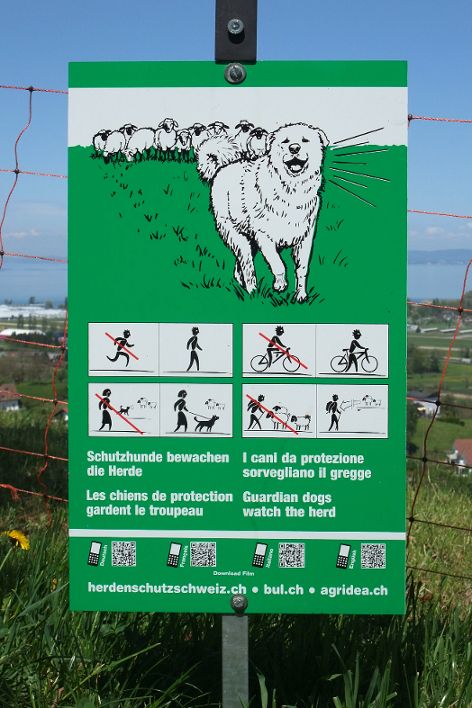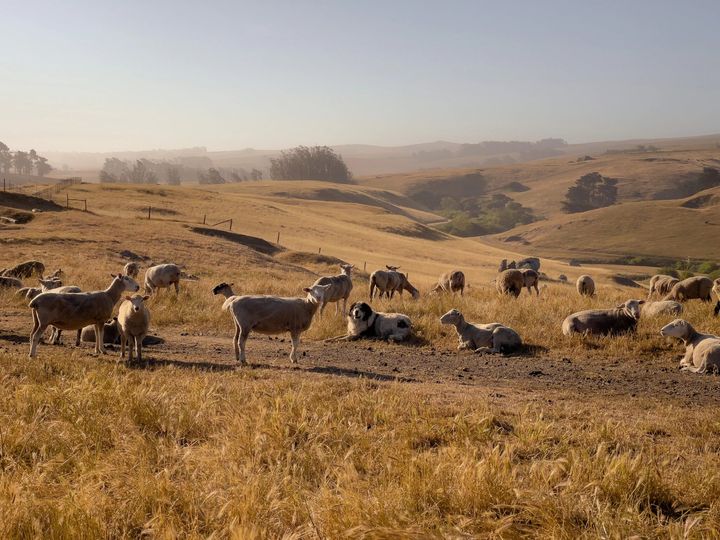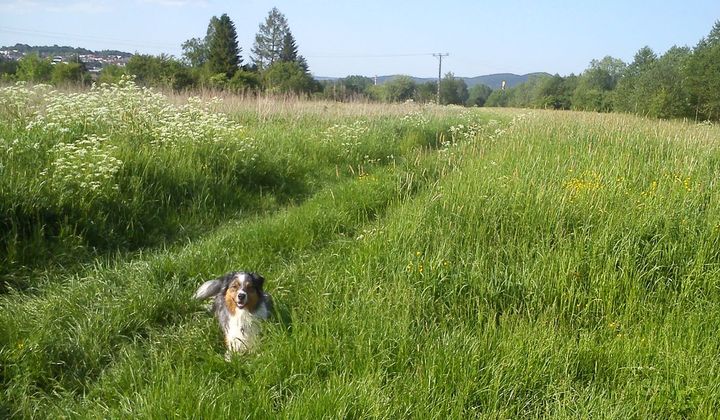Livestock-Guarding Dog's adolescence draft
Livestock-guarding dogs work autonomously. Immediate reaction on stranger's approaching (predatory animal, unrecognised person) is essential - LGD intends to distract an intruder closing in, to prevent a potential attack on grazing animals within protected pasture.

Switzerland keeps being a pioneer and leader in herd management experiments since 1999, which means using passive non-lethal methods like fladry and/or fences to protect livestock against predators, and active non-lethal methods like shepherds (herding dogs) and sheepdogs (livestock-guarding dogs) supporting correspondingly - a herder (by cooperation) and a sheepherder (independently).
A social guard dog is selected for its character, to bond with other animals. Therefore the dog must be a social animal, that is surrounded by other social animals. This is the reason why the dog cares for the sheep, as they satisfy their need for companionship.[1]
Livestock-guarding dogs work autonomously. Seemingly diurnally lethargic, they revive nocturnally - reacting to every suspect noise or movement, barking loudly using low tones, bravely looking straight into potential intruder's eyes. Every factor depends on danger rate (responding with tail wagging, invitation to play, simulated charging). Immediate reaction to approaching strangers (predatory animal, unrecognised person) is essential - LGD intends to distract an intruder closing in, to prevent a potential attack on grazing animals within protected pasture.
- socialized with livestock / cattle / other herded animals (farmer's decision)
Socialization (then habituation) is important - if not the most important - aspect of companion animal behavior, founding a base rooted in developmental offspring management - a critical period when the socialization process will be finalised permanently. To initiate it correctly, puppies should be placed directly in the sheepfold or on the grazing land (moved from time to time, to provide familiarity with the entire herd), in safe kennels (preventing potential inventory attacks) where they sleep, eat and drink water. The whole training process is finished with the sheepdog's development finale (ability to reproduce) - the young sheepdog is released into open area.
- limited in contact with humans
Domestic dog species evolved passing by predispositions to remain human focused in a natural way (inter-specific cooperation) or by human intervention (selective breeding). Elementary social behavior transferred into regular play behavior (teamwork foundation), bounds dog-human relations during sensitive period (developmental puppy management), making that connection more and more attractive to a dog. In the context of LGD training process, a dog-human contact (including limited social reward within a target environment) tends to remain reduced to the owner and family (basic needs providence - like food/water resources, safety - and livestock inspection). Otherwise, a trained guarding dog would become a casual dog abandoning the guarded herd because a human companion is preferred.
- not aggressive towards guarded animals
Mature livestock-guarding dog, accepted by grazing animals, can work standalone, without human supervision. It's a dog which reacts permissively or submissively, when sniffed by them - avoiding eye contact, putting ears back and tail down. Handler's role is to observe and spot deviating behaviors on time (instinctive bite inhibition out of control, prey drive being triggered, partial predatory sequence simulation) yet while the specific guardian dog is trained, and do not strengthen them or motivate repetitive attempts.
Due to previously collected experiences - being obligatory socialized to herded animals precisely, in the most adaptive primary developmental part - familiar non-human animals become 'imprinted' to LGD as fellow relative-likes.
- fearless, but not offensive, to a distant approacher considered as intrusive
Typical guard dogs should be heavy (up to 75kg) and large (up to 70cm). In action, guarding with a tail held up, barking determinate to charge on the source of menace, which causes an intruder to back off in order to avoid confrontation or by decision that the risk is not adequate to uncertain benefits.
Evolutionary, large sizes give guarding dogs a fearsome presence (in pair with a chance to work safe within the independently patrolled territory), make them stronger (assertive movement, fracture-immune bones) and better prepared to harsh weather conditions (cold resistance, loss warm prevention). Unified color is another adaptation passed on through genes, correlated to geographical locations where specific LGD breeds came to existence - it gives the natural camouflage (vide white mountain dogs guarding sheep in the snow covered areas or Caucasian Shepherd Dogs originally working in the rocky regions).
Looking at the adolescent dog type related sequenced predatory behavior - its canine prey drive was shaped originally to create the working dog dedicated to guarding only.
SEARCHING -> TRACKING -> STALKING -> CHASING -> GRABBING -> KILLING -> DISSECTING -> EATING
Historically, dogs which were able to attack the livestock could be used to hunt (or to herd if attack tendency was partial or moderate), whereas those which still presented youthful behavior as an adult and didn't have a drive to herd or hunt, became the perfect guarding ones. Their prey drive remained permanently and almost completely weakened.
From a behavioral perspective, LGD are predestined to interrupt a predatory sequenced behavior - to antecede SEARCHNG / TRACKING chains detected in the case of roaming wild predator or STALKING chain detected in the case of hunting one. It must be done exactly before CHASING is activated (starting from that chain prey drive is triggered and wild Canis predatory sequence is unstoppable).
So, their job is to locate potential predator and to deter it. Exemplary Polish Tatra Sheepdog doesn't try to attack the approaching predator (in order not to leave the livestock unattended) but gather up the sheep and stand by them instead; Central Asian Shepherd Dogs were bred strictly to protect the livestock against apex-predatory wolves. Both LGD breeds are territorial, protective and make fully independent decisions.
Livestock guarding dogs are territorial, and they are protective of what they believe is theirs. The “resource-guarding” that we find so unacceptable in most dogs is exactly what we desire in a guardian dog.
- Ken Ramirez says, a professional dog trainer in Karen Pryor Clicker Training Academy (KPCT), who took care of a 2-years-old female Maremma sheepdog, trained LGD for his Ranch protection because of coyotes' appearance. -
LGD are reinforced by seeing outsiders and predators leave when they bark. Ranchers who are instructed to let the dogs “feel that they are in charge” are less likely to discipline nuisance behaviors and lower the dogs’ confidence. A confident dog bred for territorial aggression will claim more territory than an insecure dog. Ranchers who are instructed to let the dogs “feel that the herd is theirs” will have the dogs sleep with the herd, establishing the dogs’ territory.[2]
Owners of Polish Tatra Sheepdogs living as companion animals (at home, in towns) report that their dogs are inclined to watch over their family by patrolling regularly every room, looking after children and remaining pets.
references:
Coppinger Raymond, Lorna "What Is a Dog?" (2016), "How Dogs Work" (2015)
"Poradnik ochrony zwierząt hodowlanych przed wilkami" SdN "WILK" (2016)
[1] KORA, Carnivore Ecology and Wildlife Management report (August 1999)
[2] Tulip Joins the Ranch


